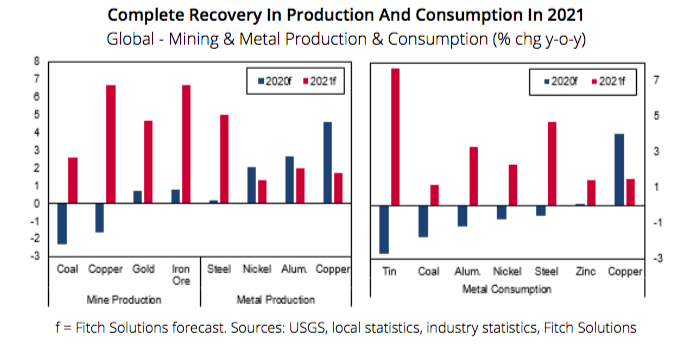In 2021, Fitch says prices will be supported by the broader and deeper global economic recovery as covid-19 vaccines are made available. Access to vaccines will also help reduce the disruptions to operations seen in 2020 in multiple key mining countries such as Peru and South Africa.

Mining and metal operations will therefore improve in 2021, says Fitch, after the sector saw significant disruptions in 2020 due to government-imposed lockdown measures, and stricter health and safety protocols.
This was particularly the case for the copper market as Peru and Chile, which account for a large share of mine output, were significantly impacted by the pandemic. The ensuing pickup in supply is likely to keep somewhat of a cap on prices.
Meanwhile, Fitch forecasts a sharp recovery in the global demand for mineral and metals in 2021. China’s metals consumption will remain strong as infrastructure projects continue to make progress, supported by the covid-19 stimulus policy.
Other countries that saw their mining and metal operations disrupted and impacted by lower end- demand will see a sharper recovery in production; such as the US, the EU, Japan and India in the case of steel and aluminium.
As overall prices, production and consumption of mineral and metals improve in 2021, the outlook for miners and metal producers is positive for next year
Fitch notes that, although it is a slow-burning and longer-term trend in nature, the ongoing acceleration of decarbonisation strategies and corporate environmental, social and governance (ESG) initiatives mean that the demand for some metals used in renewables infrastructure and electric-vehicle batteries (including copper, nickel and aluminium) could be supported in 2021 and beyond.
As overall prices, production and consumption of mineral and metals improve in 2021, the outlook for miners and metal producers is positive for next year, Fitch maintains.
The decline in input prices that Fitch forecasts for steel, due to improved supply (iron ore prices and coking coal), in 2021 will help profitability pick up in the sector.
Gold miners will continue to be supported by elevated prices. Fitch sees mining and metals capital expenditure improving in 2021, compared with 2020.
While 2020 estimates continued to deteriorate slightly as the pandemic progressed from April to November, the spending outlook for 2021 consequently improved. This shift is likely due to firms postponing growth projects from 2020 to 2021 and focusing on preserving cash in the interim, amid the pandemic.




